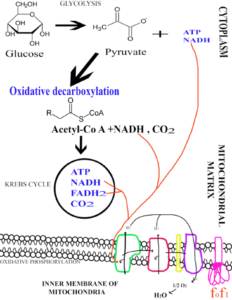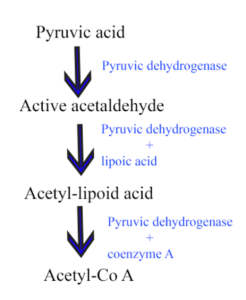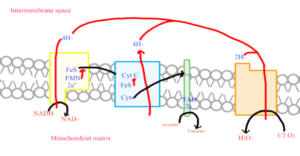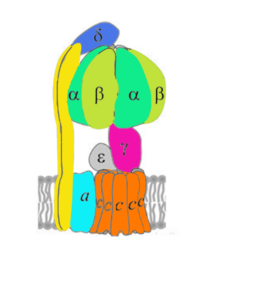Respiration can be of two types:
- When there is no oxygen present (Anaerobic)
- When there is the presence of oxygen (Aerobic)
In Anaerobic respiration, the final electron acceptor isn’t O2 whereas in aerobic respiration the final electron acceptor is O2 that gets converted to a water molecule.
Fermentation is a good example of anaerobic respiration.
C6H12O6 Fermentation 2C2H3OH + CO2 + Energy
What is cellular respiration?
Cellular respiration is a complex metabolic pathway in which the glucose is broke down and get converted into an energy molecule (ATP).Cellular respiration is the process by which we can understand how a carbohydrate molecule is converted into an energy molecule in the form of ATP (Adenosine triphosphate) inside our body.
In cellular respiration, the glucose molecule is converted into CO2 and H2O with the production of ATP molecules.
A-P~P~P (ATP) = A-P~P (ADP) + Pi +7300 calories

Oxidation of carbohydrates
Carbohydrates enter in cells in the form of monosaccharides (Glucose or glycogen). Then these monosaccharides get converted into pyruvic acid which is a 3 Carbon compound by a different reaction and by the help of various enzymes. The process of conversion, of monosaccharides into pyruvic acid is known as Glycolysis (Embden-Meyerhof pathway). Glycolysis takes place in the cytoplasm of the cell. The product of Glycolysis then enters in the mitochondria for its oxidation known as metabolic pathways:
- Glycolysis (Embden-Meyerhof pathway)
- Oxidative Decarboxylation
- Krebs cycle, TCA (tricarboxylic acid cycle)
- Oxidative phosphorylation
Conversion of glucose into pyruvic acid in by the help of various enzymes, and it didn’t require oxygen.
Steps:

- Activation: in initial reactions (1-3) the molecule of glucose, converted to fructose 1-6-diphosphate and this requires 2 molecules of ATP.
- Cleavage: in intermediate reactions (4,5) fructose 1-6-diphosphate splits into two end products.
- Oxidation: in reactions 6-10 two molecules of glyceraldehyde 3-phosphate are oxidized and eventually converted to pyruvic acid.
In the case of anaerobic respiration, the product of glycolysis is converted to ethanol. The reaction for anaerobic respiration is:
C6H12O6 > CH3CO.COOH > CH3CHO > CH3CH2OH
Glucose pyruvic acid acetaldehyde ethyl alcohol
The product of glycolysis which is pyruvic acid contains a large amount of energy, it needs further degradation, and this is done in three consecutive steps:
Oxidative Decarboxylation, Krebs cycle, and oxidative phosphorylation
Oxidative Decarboxylation
After the glycolysis pyruvic acid directly enters the mitochondrial matrix and gets converted to acetyl-CoA.
Steps:

Krebs cycle
Two molecules of acetyl CoA from oxidation passes through a series of the reaction of the Krebs cycle which is also known as TCA (tricarboxylic acid cycle)
Steps:
Oxidative phosphorylation
Two molecules of FADH2 and six molecules of NADH produced from the Krebs cycle are oxidized by O2 in ETS (electron transport system)

Compound occur in ETS
- Pyridine linkage dehydrogenase: Requires as their coenzyme either NAD+ or NADP+ both can accept two electrons at a time.
- Flavin-linked dehydrogenase (flavoproteins) as FAD or FMN
- Ubiquinone’s (coenzymes)
- Cytochromes are the proteins containing iron-porphyrin groups.
- Iron-sulfur proteins FeS are electron carriers of mitochondria.
Three complexes of the ETS
- The NADH-dehydrogenase complex largest of all the complexes, with about 800,000 Daltons mass and more than 22 polypeptide chains.
- The b-c1 complex contains 8 different polypeptide chains and it is a dimer of about 500,000 Daltons.
- The cytochrome oxidase complex comprises of eight different polypeptide chains and isolated as a dimer of 300,000 Daltons approx.
F0F1 complex
It is the one of most important and main proteins in the inner mitochondrial membrane.
It helps in ATP synthesis and known as a proton pump.

F0 complex is an integral membrane complex composed of hydrophobic proteins
F1 complex attached to he F0 complex F1 particles a complex of five distinct polypeptides alpha(α), beta (β), gamma (γ), delta(𝛿), epsilon (€).
I think that is among the most vital info for me. And im satisfied studying your article. However wanna remark on few general things, The site style is perfect, the articles is really nice : D. Good job, cheers